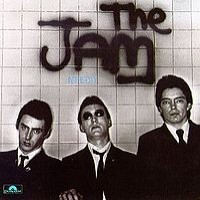There’s a little saying that The Clash used to say to each other when times got tough: “It could be worse. We could be The Jam.” Punk rock had been intended to be a new beginning for rock and roll, a rebellion against the 1960’s culture and a return to the roots of rock music. The Clash’s song, “1977,” was an encapsulation of that ethos with its chorus of “No Elvis, Beatles, and the Rolling Stones.” Except, even The Clash didn’t believe that completely. They may not have been rabid fans of any of those artists, but they didn’t despise them completely. Elvis Presley’s death in 1977 was said to have become a day of truce between punks and Teddy Boys in England, with some punks admitting, now that he was dead, that they actually appreciated Elvis. Mick Jones of The Clash was actually a big fan of stadium rockers, and didn’t find the courage to admit that to his bandmates until late in their career. It’s into this culture that launches The Jam, the first band to combine punk rock with mod rock revival, introducing elements of early Beatles, the Kinks, and the Who. This was in stark contrast to everything that punks railed against about the 1960’s, even if the punks were mostly just posturing in their hatred of mods. In a way, The Jam became an inadvertent rebellion against the punk rebellion. No wonder The Clash at least pretended to hate them.
In The City was The Jam’s debut album, and as such it was the rawest, most punk album of their catalogue. Frontman Paul Weller would turn 19 only five days after the release of In The City, so “Art School” kicks off the album with a celebration of the freedom of going off to college, particularly a very permissive art school. “Slow Down” was a cover of an old blues song by early rock and roll artist named Larry Williams that ha7d been covered by many other artists, most notably the Beatles. Not too many punk groups dabble in the blues, but The Jam make a great cover out of it. Before they had even been signed, “Slow Down” had been a common song of their early live sets. Of course, the album’s other cover stands as one of the greatest punk rock covers of all time. I’m talking, of course, about their cover of the “Batman Theme.” Okay, I’m kidding a little bit, but I do love their cover of it where they give it a blisteringly fast drumbeat and a classic mod bassline. It was another obvious song for them to cover as it had already been covered by the Who and the Kinks.
The album’s title track, “In the City,” became their first single, although it was an unsuccessful one at the time. The song actually steals its title from an obscure Who B-side of the same name. It’s a sort of celebration of youth culture, but it’s also got a very political section about police brutality that almost seems out of place, in which Weller sings: “In the city, there's a thousand men in uniform/And I hear they now have the right to kill a man.” While it sounds reminiscent of modern day America, I would like to remind you that only 10% of police officers in the UK carry guns, meaning that if a cop wants to kill you, he has to really want it. “Time for Truth” was one of their most political songs and caught some heat from the punk community because it seems to be bemoaning the loss of the British empire and expressing hope to return to it. The nature of Paul Weller’s politics are a complicated topic of debate, but it seems that, at least in 1977, he did not consider himself a conservative. The album’s closing track, “Bricks and Mortar” critiques the tearing down of old houses while homeless people continue to live on the streets, which contradicts the assumption that Paul Weller is some sort of hardline conservative.
Ultimately, punk rock seems to have grown out of its complete rejection of 60’s culture and mod rock, as evidenced by things like the German punk band the Punkles, which did almost nothing but punk covers of Beatles songs, or Dennis Lyxzén’s band The (International) Noise Conspiracy, a socialist mod-punk band that Lyxzén started after the disbanding of his experimental hardcore band, The Refused. I like to think that The Jam went a long way towards helping the punk movement drop that particular prejudice against mod rock. The Jam would put out another album, This is the Modern World, less than seven months after In the City. Due to it being so rushed into production, it ended up receiving mostly mediocre reviews. It wasn’t until the following year, 1978, that they finally had a huge financial and critical hit with their more polished album, All Mod Cons. For my money, though, Sound Affects is their true masterpiece. Ultimately, they would put out six studio albums before they broke up, and Paul Weller, to this day, insists the band will never reunite. Weller went on to a successful solo career, his latest album having been released earlier this year. Bassist Bruce Foxton joined Stiff Little Fingers in 1991 and stayed with them for 15 years. In 2005, original Jam drummer Rick Buckler started a band called The Gift, named after The Jam’s last album, which performed nothing but old Jam tunes. In 2007, Foxton joined The Gift and it became renamed From The Jam. Buckler left From The Jam in 2009, but the band continues to this day with Foxton as the only actual member of The Jam in what is more or less a Jam cover band. Really, they’ve all had extensive and brilliant careers since this twangy little mod/punk album that launched them in the first place.
